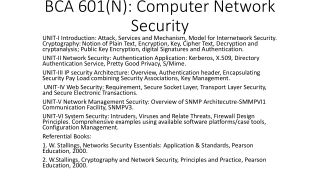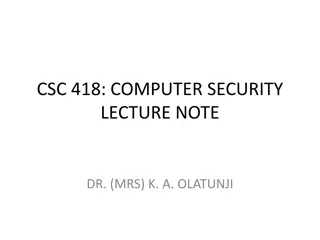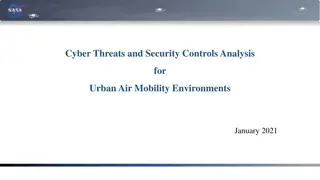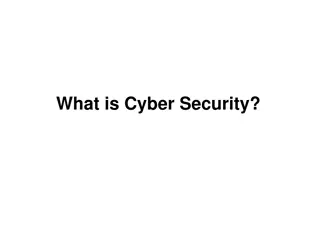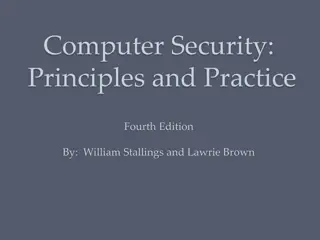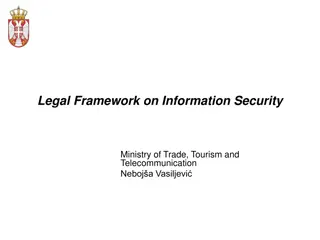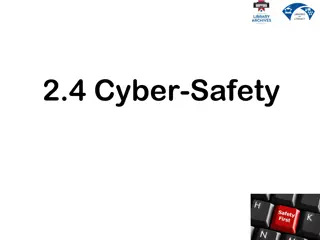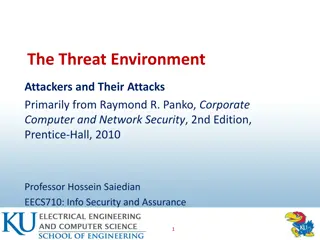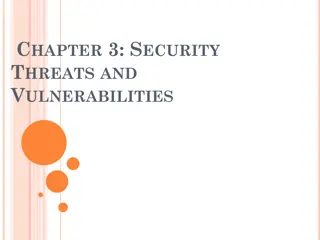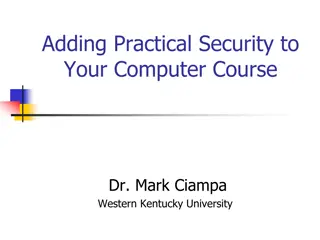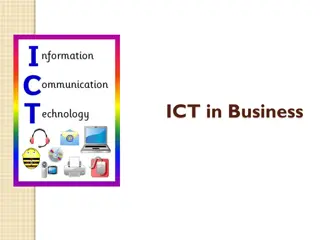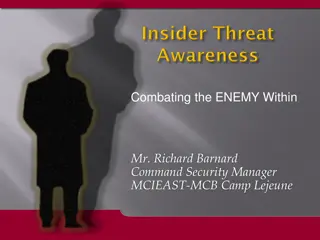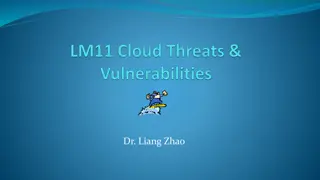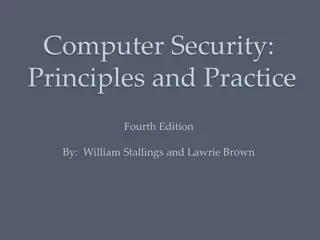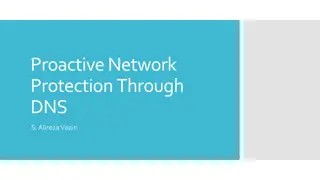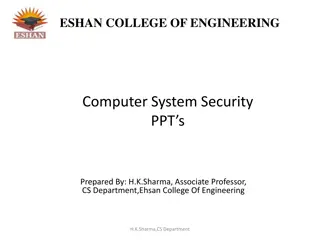Understanding Network Security Threats and Goals in Computer Systems
Explore the concept of threats in communication networks, including examples of attacks such as hacking and data disclosure. Learn about key security goals like confidentiality, data integrity, accountability, availability, and controlled access. Discover technically defined threats like masquerade, eavesdropping, and denial of communication acts.
Download Presentation

Please find below an Image/Link to download the presentation.
The content on the website is provided AS IS for your information and personal use only. It may not be sold, licensed, or shared on other websites without obtaining consent from the author. Download presentation by click this link. If you encounter any issues during the download, it is possible that the publisher has removed the file from their server.
E N D
Presentation Transcript
Prof. Dr.-Ing. Jochen Schiller Computer Systems & Telematics TI III: Operating Systems & Computer Networks Network Security Prof. Dr.-Ing. Jochen Schiller Computer Systems & Telematics Freie Universit t Berlin, Germany TI 3: Operating Systems and Computer Networks 13.1
Content 8. Networked Computer & Internet 9. Host-to-Network 10. Internetworking 11. Transport Layer 12. Applications 13. Network Security 14. Example TI 3: Operating Systems and Computer Networks 13.2
Network Security TI 3: Operating Systems and Computer Networks 13.3
Threats in a Communication Network Abstract definition: -A threat in a communication network is any possible event or sequence of actions that might lead to a violation of one or more security goals. -The actual realization of a threat is called an attack. Examples: -A hacker breaking into a corporate computer -Disclosure of emails in transit -Someone changing financial accounting data -A hacker temporarily shutting down a website -Someone using services or ordering goods in the name of others One attack may facilitate another, more serious one TI 3: Operating Systems and Computer Networks 13.4
Security Goals Technically Defined Confidentiality -Data transmitted or stored should only be revealed to an intended audience -Confidentiality of entities is also referred to as anonymity Data Integrity -It should be possible to detect any modification of data -This requires to be able to identify the creator of some data -Checksums are insufficient, as they could be manipulated, too Accountability -It should be possible to identify the entity responsible for any communication event Availability -Services should be available and function correctly Controlled Access -Only authorized entities should be able to access certain services or information TI 3: Operating Systems and Computer Networks 13.5
Threats Technically Defined Masquerade -An entity claims to be another entity, e.g. address spoofing Eavesdropping -An entity reads information it is not intended to read Authorization violation -An entity uses a service or resources it is not intended to use Loss or modification of (transmitted) information -Data is being altered or destroyed, e.g. files or packets Denial of communication acts (repudiation) -An entity falsely denies its participation in a communication act Forgery of information -An entity creates new information in the name of another entity Sabotage -Any action that aims to reduce the availability and / or correct functioning of services or systems TI 3: Operating Systems and Computer Networks 13.6
Threats and Technical Security Goals General Threats Technical Security Goals Masquer- ade Eaves- dropping Authori- sation Violation Loss or Mo- dification of (transmitted) information Denial of Communi- cation acts Forgery of Infor- mation Sabotage (e.g. by overload) Confidentiality x x x Data Integrity x x x x Accountability x x x x Availability x x x x Controlled Access x x x Threats are often combined in order to perform an attack TI 3: Operating Systems and Computer Networks 13.7
Communications Security Terminology Security Service -Abstract service that seeks to ensure a specific security goal -Can be implemented with the help of cryptographic algorithms and protocols as well as with conventional means Example: One can keep an electronic document on a USB stick confidential by storing it on the stick in an encrypted format as well as locking away the stick in a safe -Combination of cryptographic and other means usually most effective Cryptographic Algorithm -Mathematical transformation of input data (e.g. confidential data, key) to output data that suffices certain properties (e.g. collision resistant hard to find two inputs that results in same output) -Cryptographic algorithms are used in cryptographic protocols Cryptographic Protocol -Series of steps and message exchanges between multiple entities in order to achieve a specific security objective -Not tied to a particular algorithm, rather classes of algorithms as components (e.g. cryptographic hash, symmetrical encryption) TI 3: Operating Systems and Computer Networks 13.8
Basic Security Services Authentication -Most fundamental security service which ensures, that an entity has in fact the identity it claims to have Access Control -Controls that each identity accesses only those services and information it is entitled to Confidentiality -Most popular security service, ensuring secrecy of protected data Integrity -Ensures, that data created by specific entities may not be modified without detection -In some way, little brother of authentication service Non-repudiation -Protects against entities participating in communication exchange can later falsely deny that the exchange occurred TI 3: Operating Systems and Computer Networks 13.9
Cryptology Definition / Terminology Cryptology -Science concerned with communications in secure and usually secret form -Term is derived from the Greek krypt s (hidden) and l gos (word) -Cryptology encompasses: -Cryptography (gr phein = to write): Study of principles and techniques by which information can be concealed in ciphertext and later revealed to legitimate users by employing a secret key -Cryptanalysis (anal ein = to loosen, to untie): Science (and art) of recovering information from ciphers without knowledge of the key Cipher -One class of cryptographic algorithms -Others classes: Hash functions, pseudo-random number generators, ... -Method of transforming a message (plaintext) to conceal its meaning -Transformation usually takes message and a (secret) key as input -Also used as synonym for the concealed messages (ciphertext) Source: Encyclopaedia Britannica TI 3: Operating Systems and Computer Networks 13.10
Cryptographic Algorithms For network security, two main applications of cryptographic algorithms are of principal interest -Encryption of data: Transforms plaintext data into ciphertext in order to conceal its meaning -Signing of data: Computes a check value or digital signature to a given plain- or ciphertext that can be verified by some or all entities being able to access the signed data -Some cryptographic algorithms can be used for both purposes; some are only secure and/or efficient for one of them Principal categories of cryptographic algorithms: -Symmetric cryptography using one key for en-/decryption or signing/checking -Asymmetric cryptography using two different keys for en-/decryption or signing/checking -Cryptographic hash functions (using no keys) - Key is not an input, but may be appended to or mixed with data TI 3: Operating Systems and Computer Networks 13.11
Questions & Tasks -How is user authentication often implemented? Does this really authenticate a user? Alternatives? -Why is non-repudiation important in a business context? -Which security goal(s) cannot be achieved via cryptography? TI 3: Operating Systems and Computer Networks 13.12
Symmetric Encryption Same key KA,Bis used for enciphering and deciphering of messages between entities A and B Encrypt Plain- text Cipher- text Decrypt Cipher- text Plain- text Notation for plaintext message P: -E(KA,B, P) denotes ciphertext -D(KA,B, E(KA,B, P)) = P holds Pro: Short key size, efficient implementations; Contra: Key distribution Examples: Data Encryption Standard (DES), 3DES, International Data Encryption Algorithm (IDEA), Advanced Encryption Standard (AES), ... TI 3: Operating Systems and Computer Networks 13.13
Asymmetric Encryption Use two different keys +K and -K for encryption and decryption -Key -K is only known to entity A and is called A s private key -KA -Key +K can be publicly announced and is called A s public key +KA Encrypt Plain- text Cipher- text +K Decrypt Cipher- text Plain- text -K Given a random ciphertext c = E(+K, m) and +K, it should be infeasible to compute m = D(-K, c) = D(-K, E(+K, m)) Hence, it should be infeasible to compute -K when given +K Pro: (Partially) solves key distribution problem; Contra: Large key size, inefficient implementation Examples: RSA, ElGamal, Elliptic curves, ... TI 3: Operating Systems and Computer Networks 13.14
Asymmetric/Public-key Cryptography Applications: -Encryption If B encrypts a message with A s public key +KA, she can be sure that only A can decrypt it using - KA -Signing If A encrypts a message (or hash of a message) with his own private key -KA, everyone can verify this signature by decrypting it with A s public key +KA It is crucial that everyone can verify that s/he really knows A s public key and not the key of an adversary! Practical considerations: -Asymmetric cryptographic operations are about magnitudes slower than symmetric ones Only rarely used for encrypting/signing bulk data -Symmetric techniques are used to encrypt/compute a cryptographic hash value and asymmetric cryptography is just used to encrypt key/hash value -Public Key Infrastructure (PKI) or web of trust (e.g. PGP) needed TI 3: Operating Systems and Computer Networks 13.15
Example: Classical E-Mail protection via PGP Encryption and authentication of emails: MD5 (Message Digest 5) calculates hash value of message No message resulting in same hash value should be constructible within reasonable time RSA (Rivest, Shamir, Adelman) authenticates sender and receiver: -Each user has a known public and a private key -Sender uses its private key to encrypt the MD5 hash value Authentication of sender possible -Public key of the receiver is used to encrypt IDEA key Authentication of receiver IDEA (International Data Encryption Standard) conceals message: Message and hash encrypted using IDEA random key Randomly generated IDEA-Key Public Key (Receiver) RSA Private Key (Sender) Hash value + + MD5 RSA ZIP IDEA base64 message TI 3: Operating Systems and Computer Networks 13.16
Example: HTTP over TLS/SSL HTTPS authenticates server and establishes secure connection: 1) Propose SSL parameters, send random number 2) Agree to parameters, send random number 3) Send public key certificate 4) Conclude handshake negotiation 5) Send random number encrypted with server s public key - Client and server derive session key from all three random numbers 6) Activate negotiated parameters 7) Send encrypted hash over previous messages - Server decrypts and verifies message 8) Activate negotiated parameters 9) Send encrypted hash over previous messages - Client decrypts and verifies message 1 2 3 4 5 6 7 8 9 Proceed to exchange regular HTTP data over secure channel Source: Cisco Systems. Application Control Engine Module SSL Configuration Guide TI 3: Operating Systems and Computer Networks 13.17
Network Security VPNs VPN Virtual Private Network Goal: Offer secure data exchange between remote communication partners via potentially insecure transit networks, e.g. the Internet End-to-End Site-to-Site site A site B End-to-Site Provider Implemented using authentication and encryption services Different kinds of VPNs: Host-to-host, host-to-net, net-to-net (VLAN) TI 3: Operating Systems and Computer Networks 13.18
VPNs in the Internet Protection of single application layer protocols, e.g. Pretty Good Privacy (PGP), Transport Layer Security (TLS/SSL) Application Protection of TCP and UDP by modification of layer 4 in end systems (mostly proprietary) Transport Protection of IP packets by modification of IP stack, e.g. IPSec Network Protection of user data on link layer, e.g. Point-to-Point- Tunneling-Protocol (PPTP), Layer-2-Tunneling-Protocol (L2TP) Data link Physical TI 3: Operating Systems and Computer Networks 13.19
Example: IP Security (IPsec) Operation modes: Transport mode: No change in addresses (direct communication) Tunnel mode: New IP addresses between tunnel endpoints Authentication Header (AH) -Authentication, data integrity Encapsulating Security Payload (ESP) -Authentication, data integrity, confidentiality Transport mode Transport mode IP header AH payload IP header ESP header ESP trailer payload Tunnel mode Tunnel mode New IP header AH Old IP header payload New IP header ESP header ESP trailer Old IP header payload TI 3: Operating Systems and Computer Networks 13.20
Questions & Tasks -What are the pros and cons of symmetric/asymmetric encryption? -Why does asymmetric encryption only partially solve the key distribution problem? -What is the difference between a PKI and a web of trust? -How is the exchange of the symmetric key solved in PGP? -What is the basic idea of a VPN? On which layer can it operate? TI 3: Operating Systems and Computer Networks 13.21
Network Security: Internet Firewalls Network firewall can be compared to a castle moat -Restricts people to entering at one carefully controlled point -Prevents attackers from getting close to other defenses -Restricts people to leaving at one carefully controlled point Usually, firewall is installed at point where protected subnetwork is connected to a less trusted network Example: Connection of corporate local area network to the Internet Internet Firewall Some firewalls also implement access control on subnetwork level TI 3: Operating Systems and Computer Networks 13.22
Firewalls: Terminology (1) Firewall: -Component or a set of components that restricts access between a protected network and the Internet or between other networks Bastion Host: -Computer that must be highly secured because it is more vulnerable to attacks than other hosts on a subnetwork -Bastion host in a firewall is usually the main point of contact for -User processes of hosts of internal networks, and -Processes of external hosts Dual-homed host: -General purpose computer with at least two network interfaces connected to different networks Perimeter Network / De-Militarized Zone (DMZ): -Subnetwork added between external and internal network, in order to provide an additional layer of security TI 3: Operating Systems and Computer Networks 13.23
Firewalls: Terminology (2) Packet Filtering ( Screening ): -Action a device takes to selectively control flow of data to and from a network -Important technique to implement access control on subnetwork-level for packet oriented networks, e.g. the Internet Network Address Translation (NAT): -Procedure by which a router changes data in packets to modify network addresses -Allows to conceal internal network addresses (even though NAT is not actually a security technique) -Example: use of private IP addresses in home networks and for mobile phones Proxy: -Program that deals with external servers on behalf of internal clients -Relays approved client requests to real servers and also relay the servers answers back to clients TI 3: Operating Systems and Computer Networks 13.24
Firewalls Architecture: Packet Filter Simple architecture consists of a packet filtering router Implementation options: -Standard workstation (e.g. Linux PC) with at least two network interfaces plus routing and filtering software -Dedicated router device, which usually also offers filtering capabilities Firewall Internet Packet Filtering Router Denied Traffic Permitted Traffic Requires forwarding and filtering rules to operate TI 3: Operating Systems and Computer Networks 13.25
Firewall Architecture: Screened Host Packet filter ... -allows permitted IP traffic between screened host and the Internet -blocks all direct traffic between other internal hosts and the Internet Screened host provides proxy services Despite partial protection by packet filter, screened host acts as bastion host Firewall Internet Bastion Host TI 3: Operating Systems and Computer Networks 13.26
Firewall Architecture: Screened Subnet DMZ between two packet filters Inner packet filter serves as additional protection in case bastion host is compromised -Avoids that compromised bastion host sniffs internal traffic Perimeter network is also a good place to host publicly accessible information server, e.g. a WWW server Firewall Internet Bastion Host TI 3: Operating Systems and Computer Networks 13.27
Firewalls: Packet Filtering What can be done with packet filtering? -Theoretically speaking everything -All information exchanged in a communication relation is transported via packets -In practice, efficiency tradeoffs against proxy approaches have to be considered -Deep packet inspection is expensive; comes at cost of routing efficiency (but can be done!) Basic packet filtering allows to control data transfers based on: -Source/destination IP address -Transport protocol -Source / destination application port -Specific protocol flags: -No TCP SYNs from exterior network -No TCP SYN/ACKs from exterior network, unless prior and related SYN from interior network (stateful packet filtering) -Network interface a packet has been received on TI 3: Operating Systems and Computer Networks 13.28
Example: Packet Filtering Rule Set This rule set specifies that incoming and outgoing email is the only allowed traffic into and out of a protected network: -Email is relayed between two servers by transferring it to an SMTP daemon on the target server (server port 25, client port > 1023) -Rule A allows incoming email to flow to the bastion host and rule B allows the bastion host s acknowledgements to exit the network -Rules C and D are analogous for outgoing email -Rule E denies all other traffic Rule Direction Src. Addr. Dest. Addr. Protocol Src. Port Dest. Port ACK Action A Inbound External Bastion TCP >1023 25 Any Permit B Outbound Bastion External TCP 25 >1023 Yes Permit C Outbound Bastion External TCP >1023 25 Any Permit D Inbound External Bastion TCP 25 >1023 Yes Permit E Either Any Any Any Any Any Any Deny TI 3: Operating Systems and Computer Networks 13.29
Conclusion Network security is an important, but extremely complex topic Unfair by definition: -Attacker only needs to find one hole -Defender must close all holes Baofeng attack: 475 million users for 9 hours detached from the Internet We have not even scratched the surface, we just know that there is an iceberg out there TI 3: Operating Systems and Computer Networks 13.30
Content 8. Networked Computer & Internet 9. Host-to-Network 10. Internetworking 11. Transport Layer 12. Applications 13. Network Security 14. Example TI 3: Operating Systems and Computer Networks 13.31
Questions & Tasks -On which layers can a firewall operate? -What is the idea of a DMZ? -What is packet filtering? What does deep packet inspection mean? -Where is your firewall at home? Check the settings! -Why do we have cyber security problems at all? TI 3: Operating Systems and Computer Networks 13.32


